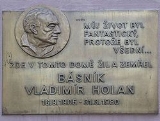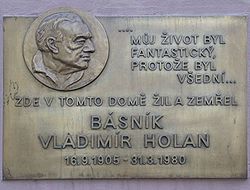
Vladimír Holan
Encyclopedia
 |
|
| Date of Birth: | September 16, 1905 |
| Place of Birth: | Prague Prague Prague is the capital and largest city of the Czech Republic. Situated in the north-west of the country on the Vltava river, the city is home to about 1.3 million people, while its metropolitan area is estimated to have a population of over 2.3 million... , Holešovice-Bubny |
| Date of Death | March 31, 1980 |
Vladimír Holan (ˈvlaɟɪmiːr ˈɦolan) (1905 - 1980) was a Czech
Czech people
Czechs, or Czech people are a western Slavic people of Central Europe, living predominantly in the Czech Republic. Small populations of Czechs also live in Slovakia, Austria, the United States, the United Kingdom, Chile, Argentina, Canada, Germany, Russia and other countries...
poet famous for employing obscure language, dark topics and pessimist views in his poems. He was nominated for the Nobel Prize
Nobel Prize
The Nobel Prizes are annual international awards bestowed by Scandinavian committees in recognition of cultural and scientific advances. The will of the Swedish chemist Alfred Nobel, the inventor of dynamite, established the prizes in 1895...
in the late 1960s. He was a member of the Communist Party of Czechoslovakia
Communist Party of Czechoslovakia
The Communist Party of Czechoslovakia, in Czech and in Slovak: Komunistická strana Československa was a Communist and Marxist-Leninist political party in Czechoslovakia that existed between 1921 and 1992....
.
Holan was born in Prague
Prague
Prague is the capital and largest city of the Czech Republic. Situated in the north-west of the country on the Vltava river, the city is home to about 1.3 million people, while its metropolitan area is estimated to have a population of over 2.3 million...
, but he spent most of his childhood outside the Capital. When he moved back in the 1920s he studied law and started a job as a clerk, a position that was a large source of dissatisfaction for the poet. He lost his father and in 1932 married Věra Pilařová. In the same year he published the collection of poems Vanutí (Breezing), which he considered his first piece of poetic art (there were two books preceding it: Blouznivý vějíř /1926/ and Triumf smrti /1930/). It was his only collection to be reviewed by the knight of Czech critics, František Xaver Šalda, who compared Holan favorably with the French poet Stéphane Mallarmé
Stéphane Mallarmé
Stéphane Mallarmé , whose real name was Étienne Mallarmé, was a French poet and critic. He was a major French symbolist poet, and his work anticipated and inspired several revolutionary artistic schools of the early 20th century, such as Dadaism, Surrealism, and Futurism.-Biography:Stéphane...
.
In the 1930s Holan continued writing obscure lyrical poetry and slowly started to express his political feelings (reacting to the Spanish Civil War
Spanish Civil War
The Spanish Civil WarAlso known as The Crusade among Nationalists, the Fourth Carlist War among Carlists, and The Rebellion or Uprising among Republicans. was a major conflict fought in Spain from 17 July 1936 to 1 April 1939...
at first). Political poems Odpověď Francii (The Reply to France), Září 1938 (September 1938) and Zpěv tříkrálový (Twelfth Night Song) were reactions to the situation in Czechoslovakia from September 1938 till March 1939. They also made him more intelligible and popular. The poem called Sen (The Dream) is a presage of a cruel war (amazingly published in the Protectorate of Bohemia and Moravia
Protectorate of Bohemia and Moravia
The Protectorate of Bohemia and Moravia was the majority ethnic-Czech protectorate which Nazi Germany established in the central parts of Bohemia, Moravia and Czech Silesia in what is today the Czech Republic...
in April 1939). During the war he published several poetic stories in verse inspired by national humiliation. After the war he published an apocalyptic record of events in his Panychida and chanted about the Red Army in Tobě (To You), Rudoarmějci (Red Army Soldiers) and Dík Sovětskému svazu (Thanks to the Soviet Union). He left the Catholic Church and became a member of the Communist Party.
In 1949 after the communist takeover he was involved in an incident against Soviet influence in the new regime and his work was on the index of Czech literature. He left the Communist Party and reentered the Catholic Church. In the last years of his life he lived in reclusive poverty in the very heart of Prague on the island of Kampa
Kampa Island
Kampa is an island in the Vltava river in central Prague on the side of Malá Strana. Charles Bridge crosses its northern tip and is connected to the island by the street Ulice na Kampě. It is separated from Malá Strana by a narrow artificial channel to the west called the Devil's Stream , a...
.
In the 1950s and 1960s he wrote longer poems with a mixture of reality and lyrical abstraction. He is best known in English for his postwar works, both the often teasingly obscure longer poem Noc s Hamletem (A Night with Hamlet, 1964) which became the most often translated Czech poem, and his short, gnomic
Gnomic
A gnomic aspect , sometimes called a neutral, generic or universal aspect or tense, is a grammatical aspect that expresses general truths or aphorisms—such as birds fly, sugar is sweet, a mother can always tell...
lyrical reflections, with occasional submerged notes of political protest. He became a legendary poet-recluse.

Jaroslav Seifert
Jaroslav Seifert was a Nobel Prize winning Czech writer, poet and journalist.Born in Žižkov, a suburb of Prague in what was then part of Austria-Hungary, his first collection of poems was published in 1921...
's Maminka one of the basic Czech children poetical works of Czech modern literature - also illustrated by Jiří Trnka
Jirí Trnka
Jiří Trnka was a Czech puppet maker, illustrator, motion-picture animator and film director. In addition to his extensive career as an illustrator, especially of children's books, he is best known for his work in animation with puppets, which began in 1946...
. When she died in 1977, Holan lost the sense of life and ceased writing. He died in a Kampa flat in 1980 and was buried in Olšany Cemetery
Olšany Cemetery
Olšany Cemetery is the largest graveyard in Prague, Czech Republic, once having as many as two million burials. The cemetery is particularly noted for its many remarkable art nouveau monuments.- History :...
.
----
A Night with Hamlet (first lines, English translation)
- In transition from nature to existence,
- walls are rather unkind,
- walls wet from the urine of talents, walls bespattered
- by eunuchs revolting against the spirit, walls not diminished
- even though they may not yet be born,
- and still walls already rounding out the fruit of the womb...

